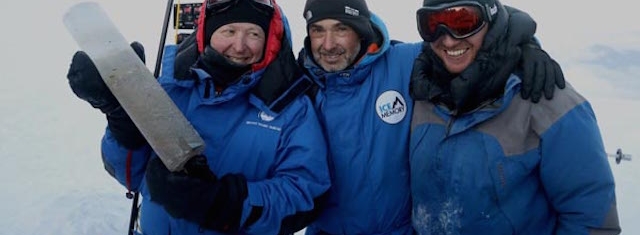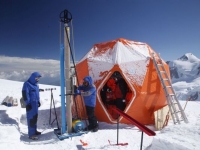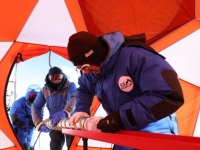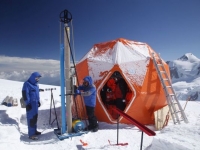Travel
THE SECOND ICE MEMORY ILLIMANI GACIER BOLIVIA EXPEDITION REACHED GRENOBLE
After A 10 000 TRIP In 50 Days

(Source: Illimina Glacier Boliiva. IRD Team)
USPA NEWS -
The two ice cores recovered from the Illimani glacier in Bolivia during the second ICE MEMORY expedition have just reached Grenoble, after a 10 000 km trip in 50 days.
Collected under extreme climatic conditions at 6 300 m above sea level,the two ice cores, with a length of 137 and 134 m and representing more than 3 tonnes of ice, divided into 250 segments of 1 m stored in fifty isothermal boxes ““ have made a trip of more than 10 000 km : firstly stored in a snow cave at the summit of Illimani, they have then been carried down by night, on the back of mountain porters, until the base camp at 4 500 m above sea level, and then carried until La Paz where they were kept in a refrigerated container at - 25°C.
Collected under extreme climatic conditions at 6 300 m above sea level,the two ice cores, with a length of 137 and 134 m and representing more than 3 tonnes of ice, divided into 250 segments of 1 m stored in fifty isothermal boxes ““ have made a trip of more than 10 000 km : firstly stored in a snow cave at the summit of Illimani, they have then been carried down by night, on the back of mountain porters, until the base camp at 4 500 m above sea level, and then carried until La Paz where they were kept in a refrigerated container at - 25°C.
The two ice cores recovered from the Illimani glacier in Bolivia during the second ICE MEMORY expedition have just reached Grenoble, after a 10 000 km trip in 50 days.
Collected under extreme climatic conditions at 6 300 m above sea level,the two ice cores, with a length of 137 and 134 m and representing more than 3 tonnes of ice, divided into 250 segments of 1 m stored in fifty isothermal boxes ““ have made a trip of more than 10 000 km : firstly stored in a snow cave at the summit of Illimani, they have then been carried down by night, on the back of mountain porters, until the base camp at 4 500 m above sea level, and then carried until La Paz where they were kept in a refrigerated container at - 25°C.----------------------------------------------------------------------------------------------
10 000 KM IN A REFROGERATED CONTAINER
10 000 km in a refrigerated containerThe container joined the Arica harbor in Chile at the end of June by truck, before going to Peru and then to France by boat. Delivered at Le Havre harbor on August 9th, the container ended its long travel by truck until Grenoble, where the ice cores are now stored in a cold room at Fontanil-Cornillon. This dangerous trip, due to the permanent risk of cold chain failure, has been coordinated by ULiSSE, a CNRS service unit dedicated to the transport and logistics of scientific equipment and products. ULiSSE implemented procedures to ensure the container´s low temperature stability during those 50 days : external generator and mobilization of a dedicated technician for the transport by truck ; supervision by the forwarder, notably during crucial steps (most important, the container´s electrical connexion after transboarding) and temperature recordings three times a day during the trip by the sea.-----------------------------------------------
THE ADVENTURE CONTINUES !
One of these ice cores will be analyzed in 2019 at the Institut des géosciences de l´environnement (IGE) of Grenoble, to track climate and environmental conditions back to 18,000 years before present. The second ice core will contribute to the first World heritage vault of ice cores, which will be built at Concordia Station in Antarctica, starting in 2020.
International teams engaged in ICE MEMORY project are now preparing others drillings on differents glaciers in the world. They also work with UNESCO to build the long term governance of theses unique environmental archives for future generations. Source IRD
Liability for this article lies with the author, who also holds the copyright. Editorial content from USPA may be quoted on other websites as long as the quote comprises no more than 5% of the entire text, is marked as such and the source is named (via hyperlink).










